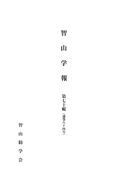Current issue
Displaying 1-13 of 13 articles from this issue
- |<
- <
- 1
- >
- >|
-
2022 Volume 71 Pages 7-66
Published: 2022
Released on J-STAGE: February 04, 2023
Download PDF (1527K) -
2022 Volume 71 Pages 67-93
Published: 2022
Released on J-STAGE: February 04, 2023
Download PDF (999K) -
2022 Volume 71 Pages 95-124
Published: 2022
Released on J-STAGE: February 04, 2023
Download PDF (823K) -
2022 Volume 71 Pages 125-142
Published: 2022
Released on J-STAGE: February 04, 2023
Download PDF (834K) -
2022 Volume 71 Pages 143-156
Published: 2022
Released on J-STAGE: February 04, 2023
Download PDF (885K) -
2022 Volume 71 Pages 157-176
Published: 2022
Released on J-STAGE: February 04, 2023
Download PDF (747K) -
2022 Volume 71 Pages 177-193
Published: 2022
Released on J-STAGE: February 04, 2023
Download PDF (697K) -
2022 Volume 71 Pages 195-213
Published: 2022
Released on J-STAGE: February 04, 2023
Download PDF (768K) -
2022 Volume 71 Pages 0013-0032
Published: 2022
Released on J-STAGE: February 04, 2023
Download PDF (1029K) -
2022 Volume 71 Pages 0033-0044
Published: 2022
Released on J-STAGE: February 04, 2023
Download PDF (790K) -
2022 Volume 71 Pages 0045-0059
Published: 2022
Released on J-STAGE: February 04, 2023
Download PDF (844K) -
2022 Volume 71 Pages 0061-0077
Published: 2022
Released on J-STAGE: February 04, 2023
Download PDF (827K) -
2022 Volume 71 Pages 0079-0091
Published: 2022
Released on J-STAGE: February 04, 2023
Download PDF (640K)
- |<
- <
- 1
- >
- >|
